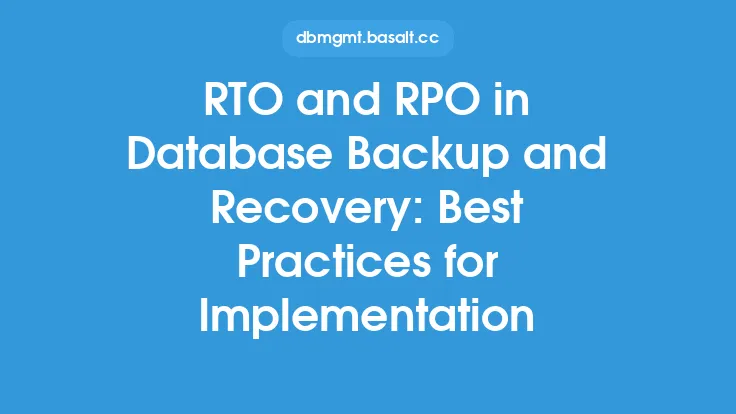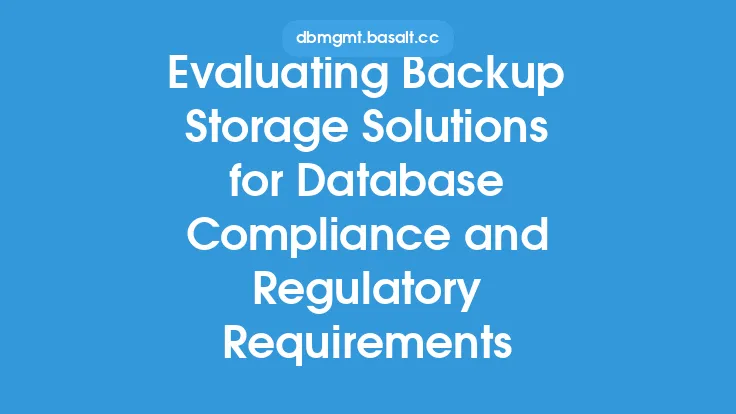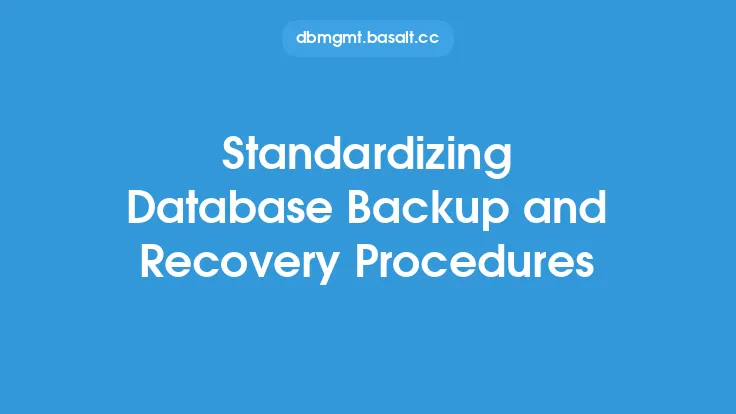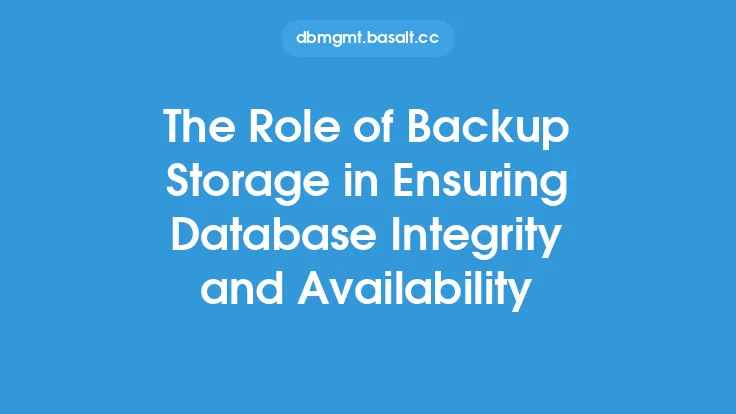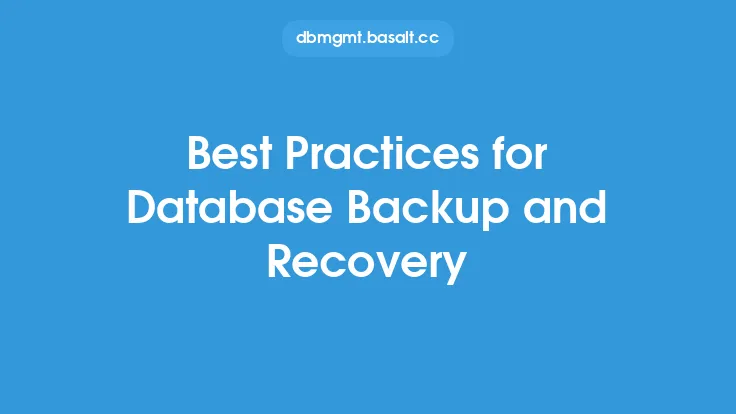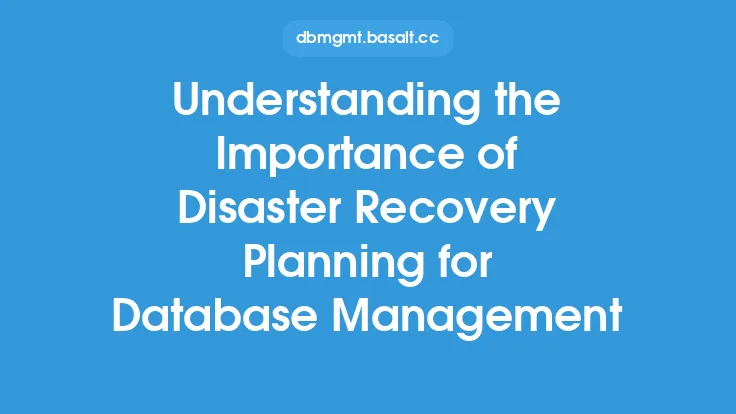Database disaster recovery and business continuity are critical aspects of any organization's data management strategy. In the event of a disaster or system failure, having a reliable backup storage solution in place can mean the difference between minimal downtime and significant data loss. Backup storage solutions for database disaster recovery and business continuity are designed to provide a secure and efficient way to store and recover database backups, ensuring that business operations can be quickly restored in the event of a disaster.
Introduction to Backup Storage Solutions
Backup storage solutions for database disaster recovery and business continuity come in a variety of forms, including disk-based, tape-based, and cloud-based solutions. Each type of solution has its own advantages and disadvantages, and the choice of which one to use will depend on the specific needs and requirements of the organization. Disk-based backup storage solutions, for example, offer fast backup and recovery times, but may be more expensive than tape-based solutions. Tape-based solutions, on the other hand, are often less expensive, but may be slower and more prone to data loss. Cloud-based solutions offer the advantage of scalability and flexibility, but may be more vulnerable to security threats.
Key Considerations for Backup Storage Solutions
When selecting a backup storage solution for database disaster recovery and business continuity, there are several key considerations that must be taken into account. These include the size and complexity of the database, the required backup and recovery times, and the level of security and encryption required. The solution must also be able to handle the required data transfer rates and must be compatible with the existing database management system. Additionally, the solution must be able to provide a high level of data integrity and availability, and must be able to support multiple backup and recovery scenarios.
Types of Backup Storage Solutions
There are several types of backup storage solutions available, each with its own strengths and weaknesses. Disk-based backup storage solutions, such as storage area networks (SANs) and network-attached storage (NAS) devices, offer fast backup and recovery times and are well-suited for large, complex databases. Tape-based backup storage solutions, such as linear tape-open (LTO) and digital linear tape (DLT), are often less expensive than disk-based solutions and are well-suited for smaller databases or for archiving data. Cloud-based backup storage solutions, such as Amazon S3 and Microsoft Azure Blob Storage, offer the advantage of scalability and flexibility and are well-suited for organizations with variable backup and recovery requirements.
Backup Storage Solution Architectures
Backup storage solution architectures can vary depending on the specific requirements of the organization. A typical architecture may include a combination of disk-based and tape-based storage, with data being backed up to disk initially and then archived to tape for long-term storage. Cloud-based solutions may use a variety of architectures, including object storage, block storage, and file storage. The architecture must be designed to provide a high level of data integrity and availability, and must be able to support multiple backup and recovery scenarios.
Data Deduplication and Compression
Data deduplication and compression are two techniques that can be used to reduce the amount of storage required for backup data. Data deduplication involves eliminating duplicate copies of data, while compression involves reducing the size of the data itself. Both techniques can be used to reduce the amount of storage required, but they can also impact backup and recovery times. Data deduplication, for example, can reduce the amount of storage required by up to 90%, but can also increase the time required to recover data. Compression, on the other hand, can reduce the size of the data by up to 50%, but can also impact the performance of the backup and recovery process.
Security and Encryption
Security and encryption are critical aspects of any backup storage solution. The solution must be able to provide a high level of security and encryption to protect against unauthorized access and data breaches. This can include techniques such as encryption, access controls, and authentication. Encryption, for example, can be used to protect data both in transit and at rest, while access controls and authentication can be used to restrict access to authorized personnel.
Backup and Recovery Processes
The backup and recovery processes are critical components of any backup storage solution. The backup process involves creating a copy of the database, while the recovery process involves restoring the database from the backup copy. The backup process can be performed using a variety of techniques, including full backups, incremental backups, and differential backups. The recovery process can be performed using a variety of techniques, including restore from backup, restore from archive, and point-in-time recovery.
Testing and Validation
Testing and validation are critical aspects of any backup storage solution. The solution must be tested and validated to ensure that it is working correctly and that data can be recovered in the event of a disaster. This can include testing the backup and recovery processes, as well as validating the integrity and availability of the data. Testing and validation can be performed using a variety of techniques, including backup and recovery simulations, data integrity checks, and disaster recovery drills.
Conclusion
In conclusion, backup storage solutions for database disaster recovery and business continuity are critical components of any organization's data management strategy. The solution must be able to provide a secure and efficient way to store and recover database backups, ensuring that business operations can be quickly restored in the event of a disaster. By considering the key considerations, types of backup storage solutions, architectures, data deduplication and compression, security and encryption, backup and recovery processes, and testing and validation, organizations can select a backup storage solution that meets their specific needs and requirements.
